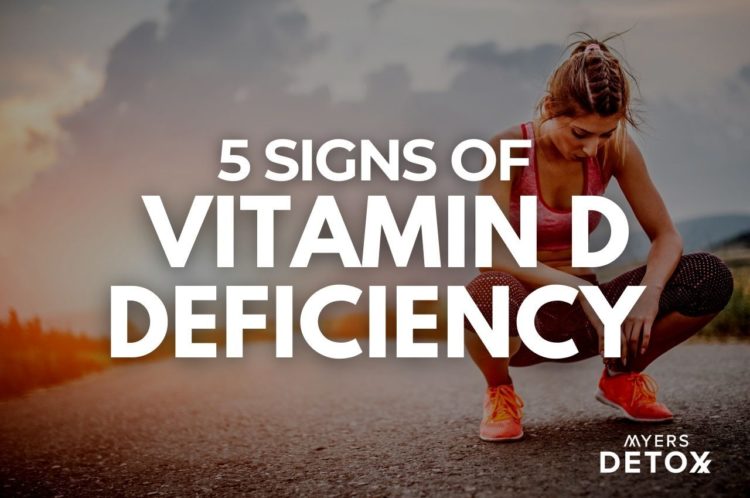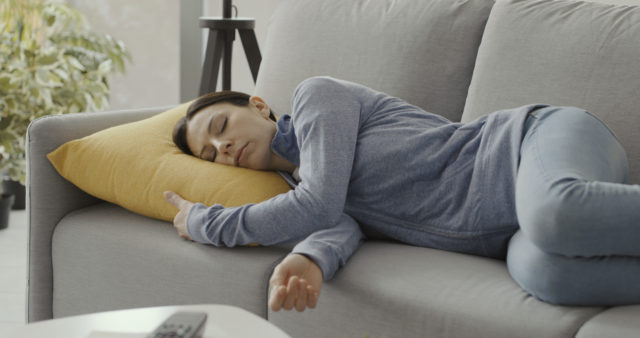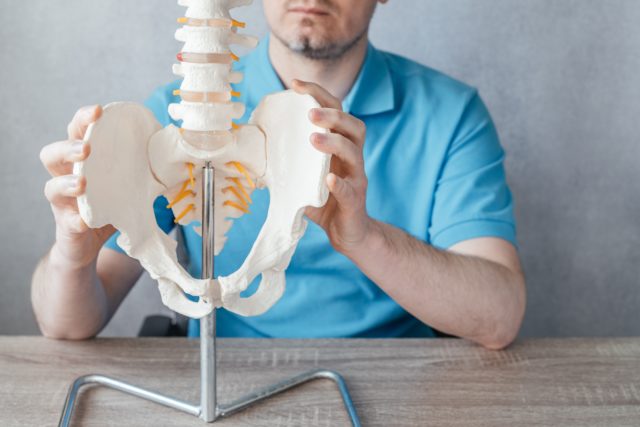5 Signs Of Vitamin D Deficiency

Are you suffering from vitamin D deficiency?
Staying on top of your nutritional needs can feel like a full-time job, especially if you’re already dealing with health challenges.
Nevertheless, keeping an eye out for symptoms of imbalance is crucial for getting ahead of full-on deficiencies.
There are currently a handful of nutrients that most Americans are low in, and vitamin D is one of them. Unfortunately, vitamin D isn’t something you can easily replete by eating the right foods.
In this article, you’ll learn:
- Why vitamin D is so vital to your health
- 5 signs that you’re low in vitamin D
- Why you should be testing for deficiency in vitamin D
- The best ways to deplete your vitamin D stores (this may surprise you)
Why Is Vitamin D Important?
Vitamin D is a fat-soluble vitamin that can be found in scant amounts in some foods but is primarily synthesized in your body with the help of ultraviolet light from the sun. In the US, vitamin D deficiency is very common, which is why many healthcare professionals recommend supplementing with this nutrient.
As an antioxidant, vitamin D protects your cells from oxidative damage, particularly your cell membrane, which is made primarily of fat.
Vitamin D is also a crucial component of your immune system and plays a vital role in healthy bones. Research also shows that vitamin D can impact neurological health, which is an area that’s getting a lot of attention these days as rates of neurological diseases are on the rise[1].
Some conditions that may result from low levels of vitamin D include[2]:
- Type 2 diabetes
- Depression
- Osteoporosis
- Certain types of cancer
- Heart disease
- Multiple sclerosis
Getting enough vitamin D in your life either through sunlight exposure, supplementation, or food is crucial for the overall health and wellbeing of your mind and body. This is why being aware of signs of deficiency is so important.
Many of the common signs of vitamin D deficiency can be mistaken for other imbalances, making spotting a deficiency a little challenging. This is why getting your vitamin D levels tested every now and then is always wise.
In the meantime, you can keep an eye out for the following common symptoms of vitamin D deficiency.
Five Signs Of Vitamin D Deficiency
#1 Fatigue

One of the more common symptoms of vitamin D deficiency is fatigue. Of course, fatigue can result from any number of factors, so these symptoms alone aren’t enough to raise a red flag – but it’s certainly something to pay attention to.
How does low vitamin D instigate fatigue?
One of the important roles that vitamin D plays is in mitochondrial health. Your mitochondria are the energy-producing machines in your cells that create the fuel your body needs in order to function. If vitamin D is low, that means that mitochondria function will suffer. When mitochondria function suffers, you won’t be able to produce enough energy to keep your body going optimally.
This means less fuel to go around, which results in becoming easily fatigued[3].
Furthermore, research shows that low levels of vitamin D may lead to poor sleep quality. Specifically, studies show that vitamin D deficiency increases the risk for sleep disorders and may more generally result in shorter durations of sleep with increased sleepiness during the day[4].
#2 Muscle Weakness Or Cramps

As you get older, the capacity of your skin to synthesize vitamin D diminishes, which is why many older people have vitamin D deficiencies. Research suggests that low levels of vitamin D in the older populations may be, in part, why you lose muscle mass and strength as you age[5].
In fact, some research suggests that low vitamin D may play a role in musculoskeletal pain, muscle wasting, and tendency towards falls in older populations[6].
Studies in animals show that vitamin D mitigates reactive oxygen species (ROS), preventing oxidative stress in the muscle. What’s more, vitamin D appears to protect muscle mitochondria against oxidative damage. Mitochondria play a vital role in muscle regeneration, assisting in their self-renewal. Therefore, the antioxidant capacity of vitamin D may play a critical role in protecting against muscle breakdown while also enhancing muscle growth[7].
#3 Weakened Immunity

Weakened immunity is another common yet general symptom of low vitamin D. Although there are many factors that can play into a weak immune system, vitamin D is well known to play a crucial role in the function of immune defenses – both innate and adaptive. In fact, many immune cells not only display vitamin D receptors, but they are also capable of synthesizing vitamin D themselves[8].
Weakened immunity may show up as persistent or frequent colds, flu, or other infections. In general, you may find that you have an illness that is just not resolving, or you may find that you’re getting sick more often.
Studies show that adequate vitamin D may be especially helpful in fighting off and protecting against respiratory tract infections such as bronchitis and pneumonia[9][10].
What’s more, research shows that vitamin D deficiency is associated with increased susceptibility to autoimmunity[8].
#4 Depression

Depression and low mood are commonly associated with low levels of vitamin D.
Although researchers aren’t quite clear on the exact mechanism, it seems to be a chicken-egg scenario. Are low levels of vitamin D driving depression? Or is there some confounding factor that is making it more difficult for people with depression to get enough vitamin D?
Research shows that there are vitamin D receptors in your brain’s hypothalamus, which is an area responsible for hormonal regulation, emotional responses, appetite, and more. This suggests that low vitamin D levels may inhibit some of the hypothalamus’s vital functions[11].
Other research shows that vitamin D is important for proper brain development. As we now know, your brain is always growing and changing due to its neuroplasticity, which could also impact your emotional regulation[12].
Either way, studies show that replenishing vitamin D in those that are deficient may be an effective way to reduce depressive symptoms, with some research even comparing vitamin D to an antidepressant[13][14].
#5 Bone Loss

Vitamin D is a vital nutrient for bone health, which is why bone pain and bone loss are both associated with low levels of this vitamin.
While calcium may be the most crucial mineral for maintaining healthy bones, vitamin D helps your body absorb calcium, therefore allowing for sufficient calcium delivery to your bones. Similar to muscle wasting, bone loss is often seen in older people that aren’t able to synthesize enough vitamin D. This means you could be consuming as much calcium as possible, but the calcium won’t make it to your bones without the help of vitamin D[15].
With that being said, getting enough vitamin D to support healthy bones is critical at every stage of the life cycle, not just in older populations[16].
How To Get More Vitamin D Into Your Body
Food
Although there are some foods that contain vitamin D, this nutrient is not abundant in the food supply. But you can get some Vitamin D from fish like salmon, herring and tuna, egg yolks, mushrooms and cod liver oil.
Food sources of vitamin D provide at best, 1,000 IUs of vitamin D. That’s one serving of salmon or cod liver oil but we need around 2000 to 3500 IUs per day for maintenance, and 6,000 IUs or more per day for reversal of deficiencies.
It is difficult to obtain the sulfated vitamin D3 from food sources alone. Highlighting the importance of sun exposure to achieving healthy vitamin D status. (18)
Supplements
If you must take a supplement, here are a few tips.
Make sure your Vitamin D supplement also has vitamin K2. While vitamin D is crucial for the absorption of calcium, vitamin K2 helps to shuttle that calcium to your bones. Therefore, taking vitamin D without K2 could increase your systemic levels of calcium without giving it a place to go. This increases the risk of calcium deposits in your soft tissues and even your arteries, which in turn can cause problems with your heart[17].
You also need magnesium to have proper vitamin d levels. You can have low vitamin D levels on tests if your magnesium levels are low.
I believe megadosing 50,000 IU a day is dangerous. This can really cause metabolic chaos in your body. You cannot force your levels of vitamin D up by taking 50,000 IU a day. There are no shortcuts. You need sunlight and good magnesium status to have healthy levels of vitamin D.
Sunlight
As mentioned, your body uses UV rays from the sun to synthesize vitamin D internally. Therefore, one of the most effective ways to enhance vitamin D production is getting more sunlight.
I don’t recommend taking vitamin D supplements unless they are in a natural form like cod liver oil. Here is why.
The kind of vitamin D you get in a supplement is NOT the same thing as what your body synthesizes via the sun. So do not think it is a replacement. According to Dr. Stephanie Seneff,
“In the presence of sunlight, skin cells produce vitamin D sulfate. That’s a water-soluble form of what is typically a fat-soluble vitamin D. The sulfate form can travel freely throughout the bloodstream but the vitamin D3 found in oral supplements is an unsulfated form that requires low density lipoprotein, LDL, so-called bad cholesterol for transport to receptor sites in the body. Vitamin D that’s in a supplement is fat soluble, so it’s got to get transported around the body within a fat, basically. Not true for the vitamin D sulfate that is produced from sunlight, because that’s water soluble and it’ll go freely through the bloodstream.”
What are the practical recommendations about getting enough sunlight, safe levels of sunlight? Morning sun is critical for circadian signaling, brain function, dopamine, serotonin and oxygenation of the blood. Midday sun is critical for the synthesis of vitamin D and cholesterol sulfate, as well as the synthesis of sex hormones and neuropeptides.
You want full body skin exposure, but cover up any sensitive skin areas like face, lips, nose, and every other sensitive area. You want to avoid burning. You need sunlight exposure to full spectrum, natural sunlight. UV lights from tanning beds can be harmful. Tanning beds, if they don’t contain a balanced mixture of light, they can be harmful. You need both UVB and UVA light for balanced health. I believe there are tanning beds now that have full spectrum light, but do your research.
Avoid tanning through a window as it will increase your skin cancer risk. The reason is windows block out protective UVB light. It’s UVA light on its own, which is linked to skin cancer, aging and darkening of the skin. When you’ve got the UVB there, it’s protective. Never sunbathe through a window.
How much do you need a day to get your 4,000 IUs a day or more? It depends on if you are deficient in vitamin D, it depends on how close to the equator you live, how much skin you expose to the sun, your weight, what season it is, what time of day, how old you are, whether you’re lying down and whether you’re wearing sunscreen. All those factors count in how much Vitamin D you can produce internally.
If you are sunbathing lying down with full skin exposure to the sun – in a bikini or trunks – you can get 4,000s of IUs vitamin D with 20 minutes of sun. Jogging or golfing with clothes on would be an hour.
Based on your skin color and body position, as well as the time of day and climate you live in, it will change your sun exposure needs in the following ways: If you’re obese, you need 2x as many minutes, so you’d need 40 minutes in the sun.
- If you are Black, it’s 5x more sun exposure.
- If it’s early morning or late afternoon, you need 2x as many minutes.
- If it’s spring or fall you need 2x as many minutes.
- If there’s smog or haze, it’s maybe 2x to 4x as many minutes
There’s also a smartphone app called DMinder that will ask for your weight, age, your geographical location, and can actually calculate how much sun exposure you need to get adequate levels of vitamin D.
No Sun? Get a Sunlamp
Unfortunately, with the way that most people live their lives in modern society, there is much more time spent inside than outside. When you can’t get UVB during the winter or you live in a cloudy climate, what do you do then? During the times of year when UVB rays are not present, you have essentially two options.
You could use a safe tanning bed, but it should also contain UVB and UVA, and it has to contain red lights. You have to be very careful if you’re using a tanning bed.
You can supplement with UVB emitting lights. There’s a UVB emitting light that you can use to supplement for vitamin D. It’s called the Sperti UVB light device, which triggers vitamin D production. The Sperti light device is about $400 or $500. It is well worth the investment and saves you on supplement costs. You can use it five to a maximum of 15 minutes a day. You’ll get your vitamin D and you don’t need to be out in sunlight. Be sure to protect yourself from getting burnt by being careful about how close you sit to the lamp and for how long you use the lamp.
Takeaway
Many of the symptoms of vitamin D deficiency can be confused with other imbalances. For instance, feeling tired or depressed may be the result of lifestyle choices, stress, and any number of physical imbalances.
This is why getting your vitamin D levels checked annually is a good idea if you are concerned about your levels.
With that being said, keep an eye out for the symptoms mentioned above, and if you notice two or more of these common symptoms, it may be a red flag that a vitamin D deficiency is developing.
Click Here for References+
- https://my.clevelandclinic.org/health/articles/15050-vitamin-d–vitamin-d-deficiency
- https://ods.od.nih.gov/factsheets/VitaminD-HealthProfessional/
- Roy, Satyajeet, et al. “Correction of low vitamin D improves fatigue: effect of correction of low vitamin D in fatigue study (EViDiF Study).” North American journal of medical sciences 6.8 (2014): 396.
- Gao, Qi, et al. “The association between vitamin D deficiency and sleep disorders: a systematic review and meta-analysis.” Nutrients 10.10 (2018): 1395.
- Venning, Geoff. “Recent developments in vitamin D deficiency and muscle weakness among elderly people.” Bmj 330.7490 (2005): 524-526.
- Tanner, S. Bobo, and Susan A. Harwell. “More than healthy bones: a review of vitamin D in muscle health.” Therapeutic advances in musculoskeletal disease 7.4 (2015): 152-159.
- Latham, Christine M., et al. “Vitamin D Promotes Skeletal Muscle Regeneration and Mitochondrial Health.” Frontiers in Physiology 12 (2021): 463.
- Aranow, Cynthia. “Vitamin D and the immune system.” Journal of investigative medicine 59.6 (2011): 881-886.
- Jat, Kana Ram. “Vitamin D deficiency and lower respiratory tract infections in children: a systematic review and meta-analysis of observational studies.” Tropical doctor 47.1 (2017): 77-84.
- Martineau, Adrian R., et al. “Vitamin D supplementation to prevent acute respiratory tract infections: systematic review and meta-analysis of individual participant data.” bmj 356 (2017).
- Penckofer, Sue, et al. “Vitamin D and depression: where is all the sunshine?.” Issues in mental health nursing 31.6 (2010): 385-393.
- Eyles, Darryl, et al. “Vitamin D3 and brain development.” Neuroscience 118.3 (2003): 641-653.
- Spedding, Simon. “Vitamin D and depression: a systematic review and meta-analysis comparing studies with and without biological flaws.” Nutrients 6.4 (2014): 1501-1518.
- Vellekkatt, F., and V. Menon. “Efficacy of vitamin D supplementation in major depression: A meta-analysis of randomized controlled trials.” Journal of postgraduate medicine 65.2 (2019): 74.
- Khazai, Natasha, Suzanne E. Judd, and Vin Tangpricha. “Calcium and vitamin D: skeletal and extraskeletal health.” Current rheumatology reports 10.2 (2008): 110-117.
- https://www.bones.nih.gov/health-info/bone/bone-health/nutrition/calcium-and-vitamin-d-important-every-age
- Van Ballegooijen, Adriana J., et al. “The synergistic interplay between vitamins D and K for bone and cardiovascular health: a narrative review.” International journal of endocrinology 2017 (2017).
- https://www.ncbi.nlm.nih.gov/pmc/articles/PMC3356951/









